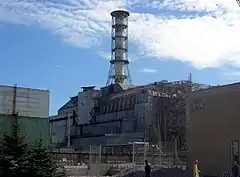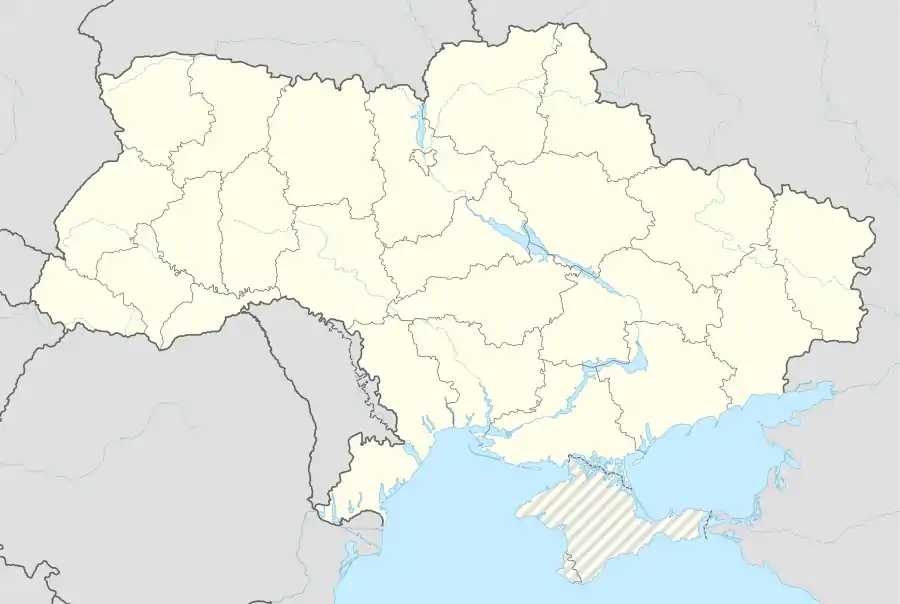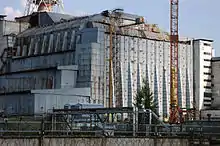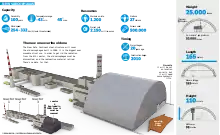Chernobyl Nuclear Power Plant sarcophagus
The Chernobyl Nuclear Power Plant sarcophagus or Shelter Structure (Ukrainian: Об'єкт "Укриття") was a massive steel and concrete structure covering the nuclear reactor number 4 building of the Chernobyl Nuclear Power Plant. It was designed to limit radioactive contamination of the environment following the 1986 Chernobyl disaster, by encasing the most dangerous area and protecting it from climate exposure.[1][2] It was located within a large restricted area known as the Chernobyl Exclusion Zone.
| Chernobyl Nuclear Power Plant Sarcophagus | |
|---|---|
Ukrainian: Укриття Чорнобильської АЕС | |
 The sarcophagus in 2006. The tall chimney is an original part of the reactor building. | |
 Location in Ukrainian SSR | |
| Alternative names | Chernobyl Nuclear Power Plant Shelter Structure |
| General information | |
| Status | Deteriorated; succeeded by Chernobyl New Safe Confinement |
| Type | Confinement shelter |
| Location | Covering Reactor 4 of the Chernobyl Nuclear Power Plant, within the Chernobyl Exclusion Zone, near Pripyat |
| Country | Ukraine |
| Coordinates | 51°23′23″N 30°05′56″E |
| Construction started | June 1986 |
| Completed | November 1986 |
| Demolished | TBC 2020 |
The original Russian name is Объект "Укрытие" (Obyekt Ukrytiye),[3] which means sheltering or covering, as opposed to sarcophagus.[2]
The sarcophagus locked in 200 tons of radioactive lava-like corium, 30 tons of highly contaminated dust and 16 tons of uranium and plutonium.[1]
By 1996 the structure had deteriorated to the point where it was deemed impossible to repair it. Internal radiation levels were estimated to be as high as 10000 röntgens per hour (normal background radiation in cities is usually around 20–50 microröntgens per hour, and a lethal dose is 500 röntgens over 5 hours).[4] A decision to replace the sarcophagus with the New Safe Confinement was taken, and a project to construct the enclosure has since been completed.
Construction
.jpg.webp)
The design of the sarcophagus started on 20 May 1986, 24 days after the disaster. Subsequent construction lasted for 206 days, from June to late November of the same year.[2] The first task before construction started was to build a cooling slab under the reactor to prevent the hot nuclear fuel from burning a hole in the base. Coal miners were called up to dig the necessary tunnel below the reactor and by 24 June 1986, four hundred coal miners had dug the 168-metre (551 ft) long tunnel.[5] When the building became overly radioactive, it became impossible to directly screw down the nuts and bolts or apply any direct welding to the sarcophagus, so this work was done by robots.[1] The seams of the sarcophagus, however, were not properly sealed.
The entire construction process consisted of eight stages: clearing and concreting of territory around reactor unit 4, erection of initial reinforced concrete protective walls around the perimeter, construction of separation walls between units 3 and 4, cascade wall construction, covering of the turbine hall, mounting of a high-rise buttress wall, erection of supports and installation of a reactor compartment covering and finally the installation of a ventilation system.
More than 400000 m3 of concrete and 7,300 tonnes of metal framework were used during the erection of the sarcophagus.[2] The building ultimately enclosed 740000 m3 of heavily contaminated debris inside,[1] together with contaminated soil.[5] On 11 October 1986 the Soviet Governmental Commission accepted a report entitled "Conclusion on Reliability and Durability of a Covering Constructions and Radiation Safety of Chernobyl NPP Unit 4 Reactor Compartment".[6] The sarcophagus has over 60 bore holes to allow observation of the interior of the core.[7] In many places the structure was designed to have ventilation shafts to allow some convection inside.[7] Filtration systems have been put in place so that no radioactive material will escape through these holes.[7]
Ongoing issues

The present shelter is constructed on top of the ruins of the reactor building. The two "Mammoth Beams" that support the roof of the shelter rest partly on the structurally unsound west wall of the reactor building that was damaged by the accident.[8] The western end of the shelter roof is supported by a wall at a point designated axis 50. This wall is reinforced concrete and was cracked by the accident.
Designed Stabilisation Steel Structure
The DSSS is a yellow steel object that has been placed next to the wrecked reactor; it is 63 meters (207 ft) tall and has a series of cantilevers that extend through the western buttress wall, and is intended to stabilize the sarcophagus.[9] This was done because if the wall of the reactor building or the roof of the shelter were to collapse, then large amounts of radioactive dust and particles would be released directly into the atmosphere, resulting in a large new release of radioactivity into the environment. In December 2006 the "Designed Stabilisation Steel Structure" (DSSS) was extended until 50% of the roof load (about 400 tons) was transferred from the axis 50 wall to the DSSS.
Upper Biological Shield
A further threat to the shelter is the concrete slab that formed the upper biological shield (UBS), situated above the reactor prior to the accident. This concrete slab was thrown upwards by the explosion in the reactor core and now rests at approximately 15° from vertical. The position of the upper bioshield is considered inherently unsafe, as only debris supports it in its nearly upright position. A collapse of the bioshield would further exacerbate the dust conditions in the shelter, possibly spreading some quantity of radioactive materials out of the shelter, and could damage the shelter itself. The UBS is a disk 17.7 meters in diameter, weighing 1000 tons and consisting of 2000 cubes, each located above a fuel channel. The shield, called the pig's nose (Пятачок: Pyatachok) before the disaster, was afterwards named Component E and nicknamed Elena. The twisted fuel bundles still attached to it are called Elena's hair.[10][11][12]
Replacement

On 22 December 1988, Soviet scientists announced that the sarcophagus would only last 20–30 years before requiring restorative maintenance work. In 1998, with the help of the European Bank for Reconstruction and Development, a conservation programme was completed that included securing the roof beams from collapsing. Nonetheless, the rain-induced corrosion of supporting beams still threatens the sarcophagus' integrity.[5] It was revealed that the water is leaking through the sarcophagus via holes in its roof, becoming radioactively contaminated, and then seeping through the reactor's floor into the soil.[5]
The New Safe Confinement, rolled into place in November 2016, allows for the dismantling of the sarcophagus and for radioactive material to be removed.[13][14] The containment was expected to replace the existing sarcophagus in 2015. However, delays and a €100 million funding gap caused a yearlong delay, before being moved into place in November 2016.
As of 2020, the building is undergoing testing of its installed systems.
References
Notes
- "Chernobyl Sarcophagus". Chernobyl International. Archived from the original on 4 December 2014. Retrieved 30 November 2010.
- Ebel 1994, p. 1
- code name given under the Soviet secrecy procedures,
- Marples 1996, p. 30
- "What happened in Chernobyl?". Greenpeace. Retrieved 30 November 2010.
- Объект "Укрытие": Сооружение (in Russian). Chernobyl.by. Retrieved 2 December 2010.
- Marples & Risovanny 1996, p. 17
- See BBC documentary Archived 29 February 2012 at the Wayback Machine
- Nuclear Engineering International, July 2007, page 12.
- "Chernobyl Glossary". Angelfire.com. Retrieved 22 March 2010.
- Ann Larabee (2000). Decade of disaster. University of Illinois Press. p. 50. ISBN 978-0-252-06820-1. Retrieved 7 November 2019.
corium silicate.
- "Chernobyl Tour". United States Environmental Protection Agency. 28 June 2006. Retrieved 7 November 2019.
- "Under The Shield: Inside Chernobyl's New Safe Confinement". RadioFreeEurope/RadioLiberty.
- Wood 2007, p. 63
Further reading
- Асмолов В. Г., Козлова Е. А. (2018). Неоконченная повесть... (in Russian). М. ISBN 978-5-88777-064-2.CS1 maint: multiple names: authors list (link)- Total pages: 336
- Ebel, Robert E.; Center for Strategic and International Studies (Washington, D.C.) (1994). Chernobyl and its aftermath: a chronology of events (1994 ed.). CSIS. ISBN 978-0-89206-302-4. - Total pages: 43
- Marples, David R.; Risovanny, Yuri (December 1990). "Revelations of a Chernobyl Insider". Bulletin of the Atomic Scientists. 46 (10): 16–21. doi:10.1080/00963402.1990.11459915. ISSN 0096-3402.
- Marples, David R. (May 1996). "The Decade of Despair". Bulletin of the Atomic Scientists. 52 (3): 20–31. doi:10.1080/00963402.1996.11456623. ISSN 0096-3402.
- Wood, Janet ;Institution of Engineering and Technology (2007). Nuclear power: Volume 52 of Power engineer (2007 ed.). IET. ISBN 978-0-86341-668-2. - Total pages: 239